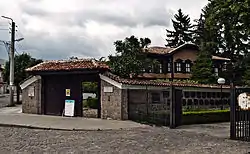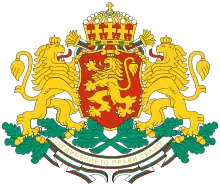Panagyurishte
Panagyurishte (Bulgarian: Панагюрище, also transliterated Panagjurište, pronounced [panɐˈɡʲuriʃtɛ]) is a town in Pazardzhik Province, Southern Bulgaria, situated in a small valley in the Sredna Gora mountains. It is 91 km east of Sofia, 43 km north of Pazardzhik. The town is the administrative centre of the homonymous Panagyurishte Municipality. As of December 2009, it has a population of 17,959 inhabitants.[1]
Panagyurishte
Панагюрище | |
|---|---|
 View of Panagyurishte from the Apriltsi Memorial Complex. | |
 Coat of arms | |
 Panagyurishte Location of Panagyurishte | |
| Coordinates: 42°30′N 24°11′E | |
| Country | Bulgaria |
| Province (Oblast) | Pazardzhik |
| Government | |
| • Mayor | Nikola Belishki |
| Elevation | 550 m (1,800 ft) |
| Population (December 2009)[1] | |
| • City | 17,959 |
| • Urban | 25,343 |
| Time zone | UTC+2 (EET) |
| • Summer (DST) | UTC+3 (EEST) |
| Postal Code | 4500 |
| Area code(s) | 0357 |
History
In the Middle Ages there was a settlement near the modern town. In the course of the Bulgarian-Ottoman Wars large part the population was killed and the rest had to move to a new location. The survivors called themselves levents due to their bravery in the struggle with the invaders.
When the Turks seized the village of Asenevtsi near Sliven which guarded the road to the capital Tarnovo, its population moved to Panagyurishte. Another wave of refugees came in the 15th century after rebellions in Albania (Debar, Prilep, Kostur and others). Even today the population uses language which is characteristic for both eastern and western Bulgarian dialects and the town is in the so-called Yat border. It was also known as "Otlukköy" during Ottoman rule.
Panagyurishte is primarily known for being the center of the April Uprising against the Ottoman rule in Bulgaria in 1876. It was capital of the Fourth Revolutionary District which was the main centre of the rebellion. The uprising was bloodily suppressed after 10 days of declared freedom, and the town was burnt down and almost completely destroyed by the Ottoman Turks. Lady Strangford arrived from Britain later that year with relief for the people of Bulgaria following the massacres that followed the April Uprising. She built a hospital at Batak and eventually other hospitals were built at Radilovo, Panagiurishte, Karlovo, Petrich and here at Perushtitsa.[2]
Tourism



Panagyurishte is overshadowed in tourism by nearby Koprivshtitsa, which has a much larger collection of restored Bulgarian Revival style houses. Like Koprivshtitsa, Panagyurishte has a picturesque location in the Sredna Gora mountains, and is one of the towns associated with the historic April Uprising in 1876. Panagyurishte also gained fame for the "Panagyurishte gold" treasure discovered there in 1949 and the Apriltsi National Memorial Complex erected in 1976 in honor of the 100th anniversary of the April Uprising. It is situated on the historic hill above the town known as Manyovo Bardo. It is also near the mineral water spas of Banya, and recreational facilities in Panagyurski koloni (Panagyur columns).
Economy
After the Second World War Panagyurishte was transformed into a large industrial center. The Asarel Medet copper extracting and processing plant is by far the largest single employer in the municipality with over 2,500 workers and also the biggest plant in its kind in the Balkans. "Opticoelectron" is an optic producing plant, unique to the country (740 workers). Recently, a new similar plant, "Optix" was launched (370 workers), Micro-VIew Endoskopie Optik J.S.C. - is founded in 2002 as a private Bulgarian-German joint stock company in Panagyurishte-the company is specialized in production of optical components for endoscopic equipment with applications in medicine and technology. There are two big textile plants: "Ryton" (880 employees) and "Bultex" (680 employees). There is also a small plastics factory, "Bunai" with some 190 workers and a number of smaller enterprises.
Places of interest

The town has two big Eastern Orthodox churches, St Georgi and St Bogoroditsa, as well as several chapels. The type of architecture of Sv. Georgi with two symmetrical bell-towers can be rarely observed in the country. There are two museums: Historical Museum and Museum of Natural History. Although the town was severely destroyed by the Turks in 1876, there are several old houses which survived and have been reconstructed, including the House-Museums of Rayna Knyaginya and Marin Drinov. The Apriltsi Memorial Complex which commemorates the April Uprising dominates the sky-line of the town and can be seen from almost every neighbourhood. It was built on the top of a hill just above the central square and includes several granite compositions which encircle the main figure. It can be reached from the center by numerous stairs. There are two theatre buildings, the Old Theatre and the New Theatre. The spacious park is situated in the north-eastern part of Panagyurishte with an artificial lake, playgrounds and the Orcho Voivoda Stadium.
There are several places of interest in the vicinity of the town. The resort village Panagyurski kolonii, literally "the colony of Panagyurishte" is located at 15 km north of the town. It is very popular with the local population, as many of the citizens have summer houses there. There is a ski run and dense beech forests rich in different species of berries and mushrooms. At 6 km to the east is the famous Oborishte locality where the plan of the April uprising was discussed and accepted by delegates from all over the province. Today there is a monument there which is popular tourist attraction.
Education and healthcare

The two largest schools are the elementary "Prof. Marin Drinov" with more than 1,100 pupils and secondary "Nesho Bonchev". Other large schools include the Optical Technikal School, Mining Technical School, "20th April" elementary school, "Sv. sv. Cyril and Metodius" elementary school and others.
A large regional hospital is located in the southernmost outskirts of the town on the western banks of the Luda Yana river. There is also a large polyclinic in the center as well as numerous private doctor and dentist cabinets.
Municipality

The town is a center of the Panagyurishte municipality which includes 9 villages: Popintsi, Oborishte, Banya, Bata, Elshitsa, Levski, Panagyurski kolonii, Poibrene and Srebrinovo, as well as the town itself.
Transport
There are roads leading to the north (Panagyurski kolonii), south (Popintsi), west (Oborishte) and east (Strelcha). The road to Popintsi, and then Pazardzhik has been recently improved and expanded. The only railway leads to Strelcha and Plovdiv. Panagyurishte has bus connections to Sofia, Plovdiv and Pazardzhik, as well as nearby villages.
Panagyurishte treasure
One frosty morning on 8 December 1949 three brothers – Pavel, Petko and Michail Deikovi – worked together in the region of "Merul" tile factory near Panagyurishte. At about ten o’clock in the morning, while processing a new layer of clay, they came across unusual glossy objects. With all of its magnificence a fabulous set of vessels glittered in front of the workers. When finally unearthed, it was found to consist of a phial and eight rhytons, one shaped like an amphora and the others like heads of women or animals. Dated to the turn of the fourth and third century BC, the find was sensational, not only for its weight in gold — over 6.146 kg of pure gold, but also for the originality of its forms. It is now a world-famous Thracian treasure and one of the most valuable possessions of the National Historical Museum.
Famous citizens
Notable natives include historian and philologist Marin Drinov (1838–1906), writer and literary critic Nesho Bonchev (1839–1878) and revolutionary Rayna Knyaginya (1856–1917).
In 1893 the Bulgarian writer Elin Pelin was enrolled in a school in Panagyurishte.
- Atanas Shopov (1855–1922) – Bulgarian diplomat and bookman.
- Georgi Bradistilov (1904–1977) – mathematician, Professor
- Damaskin Veleshki (Dimitar Ivanov Dinchev) (1817–1878), Bulgarian churchman
- Delcho Lulchev (1935–1985) – a civil engineer
- Luka Ivanov (1867–1906), Bulgarian revolutionary and military
- Nesho Bonchev (1839–1878) – the first Bulgarian literary critic, educator
- Pavel Bobekov (1852–1877) – Chairman of government during the April uprising
- Paraskeva Dzhukelova (r. 1970) – Bulgarian drama and film actress
- Petko Koychev (- 1907), Bulgarian revolutionary, died in the Battle of Nozhot
- Petar Karapetrov (1843–1905) – Bulgarian historian
- Stoyu Bradistilov (1863–1930), Bulgarian military figure, Lieutenant-General
- Stoyan Tsvetkov (1930–2007)
- Dª Carla María de la Soledad Royo-Villanova y Urrestarazu, princess of Panagyurishte, Comité de honor de fundacionarsnova, wife of Prince Kubrat
Honour
Panagyurishte Nunatak on Greenwich Island in the South Shetland Islands, Antarctica is named after Panagyurishte.
References
- (in English) Bulgarian National Statistical Institute - towns in 2009
- Shurbanov, Alexander (1996). Victorian England ~ Literary Perspective in Bulgaria. Sofia.
External links
| Wikimedia Commons has media related to Panagyurishte. |
- Official site of the Panagyurishte municipality
- Information about Panagyurishte
- Information about the municipality
- A guide for Panagyurishte
- Historical Museum
- Radio and television in Panagyurishte
- The Panayurishte golden treasure and its founders - the Deikovi brothers
- Town of Panagyurishte at Bulgariatravel.org - Official Tourism Portal of Bulgaria

